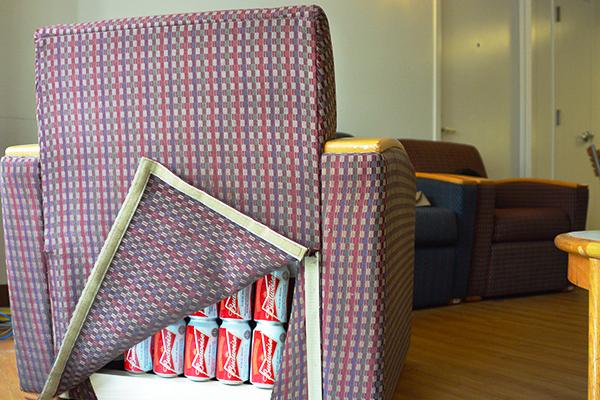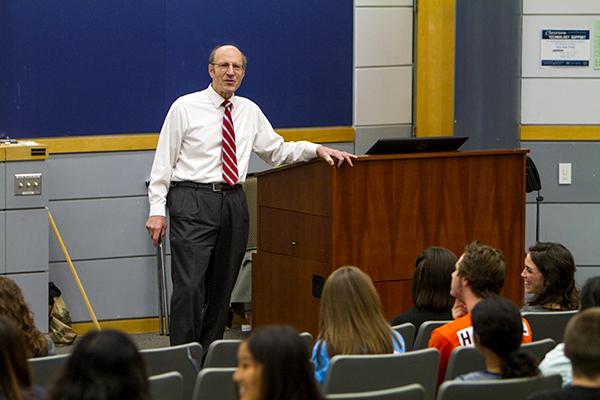No one asks as many questions as a visiting parent. It tends to help to know the answers. When walking around D.C., you already know all the major spots – the White House, the Washington Monument – and campus landmarks like the Marvin Center and the Smith Center are all obvious to point out.
But what about the smaller statues that could catch a parent’s eye or the buildings that aren’t prominently labeled? Impress your family with your knowledge of lesser-known city and campus features with this guide.
On campus
Women’s Studies building

By now the big buildings in Foggy Bottom like Whole Foods, the hospital and the Science and Engineering Hall are all too familiar. But sitting in the shadow of the construction is a campus oddity – the 40-year-old Women’s Studies townhouse.
The fading white bricks date back to 1972 when the undergraduate major and minor first started at GW. Although it looks unassuming from the outside, the homey space inside holds professors’ and teaching assistants’ offices. Faculty invite students to meet with them or use the building’s small library to study.
837 22nd St.
Textile Museum

The complex for the GW Museum and the Textile Museum provide more than just a shortcut to classes through University Yard – when the building opens in March, it’ll be a good stop for parents who are interested in art or history.
But for now, you just have to look from the outside while you walk around campus. The Textile Museum’s modern appearance gives way to its collection of over 19,000 textiles and related objects spanning five millennia and six continents. And instead of telling the story of the founding and evolution of D.C. through books, the Albert H. Small Washingtoniana Collection tells it through photographs, maps, newspapers and other artifacts.
Across from Monroe Hall on 21st Street
Pushkin statue

Hidden in the small green space beyond the variety of food trucks on H Street lies the overlooked statue of Alexander Pushkin. Erected in the year 2000, this is the first U.S. memorial dedicated to the Russian poet and writer.
“This statue serves as a great inspiration to our students who are drawn to the elegance, wit and lightness of Pushkin’s language and the accessibility of his imagery,” former University President Stephen Joel Trachtenberg said when the memorial was installed, according to the GW and Foggy Bottom Historical Encyclopedia.
The top of statue is marked by a golden pegasus, the symbol for poetry.
Outside Smith Hall at the corner of 22nd and H streets
Hippo statue

From rumors of rubbing his nose for good luck before exams to legends of George and Martha Washington seeing one from their Mount Vernon porch on a summer evening, the hippo has become an unofficial mascot ever since its installation in 1996.
Trachtenberg gave the Bronze hippopotamus to the Class of 2000 as a gift, and today is one of GW’s most popular photo opportunities.
In front of Lisner Auditorium at the corner of 21st and H Street
Poseidon
Poseidon, a stainless steel sculpture representing aspirations of grace and beauty, was originally intended to be installed in Athens. Created in 1960 by Greek sculptor George Zongolopoulos, who died before it could be installed, it is now the first modern Greek sculpture to be placed on public grounds in D.C.
Thanks to the George Zongolopoulos Foundation as well as the efforts of GW alumnus and curator George Stathopoulos, the 12-foot-tall sculpture is permanently displayed in the courtyard of the Milken Institute School of Public Health. It is valued at $90,000.
Courtyard of the Milken Institute School of Public Health
Off campus
The Watergate complex

Everyone is familiar with the Watergate scandal, but the building itself can blend into the city landscape. On your way to the waterfront, highlight the circular complex during your walk.
And for added fun facts, be sure to mention that students from the University were involved in the scandal.
-
– William Mark Felt, better known as “Deep Throat,” had gone to night law school at GW before joining the FBI.
– Bob Woodward took graduate courses at the University, including an English class about Shakespeare and a history course in international relations.
– Charles Colson, who served as special counsel to President Richard Nixon, was a law student at GW.
The Watergate complex itself has two residential buildings where well-known figures like Alfred S. Bloomingdale, Condoleezza Rice, Ben Stein and Paul O’Neill once lived.
1818 H St. NW.
National Law Enforcement Officers Memorial
Since its dedication on Oct. 15, 1991, the National Law Enforcement Officers Memorial honors those who have made the ultimate sacrifice for the protection of others.
Tall topiaries line the path of the two curving, 304-foot-long blue-gray marble walls with the names of more than 20,000 officers dating back to the first recorded death in 1791. Lion statues peer down on the list, which grows each spring as the names of fallen officers are added.
E Street between 4th and 5th streets NW.
Smithsonian Castle
The Smithsonian Castle is widely recognized as the home base of the Smithsonian museums found throughout D.C. Even though there’s not much to do inside, the newly renovated exterior is nice to point out while walking on the National Mall.
Also known as the Smithsonian Institution Building, the castle was designed for the first secretary of the Smithsonian, Joseph Henry, by architect James Renwick Jr. in 1855. At the time of the building’s construction, a canal isolated it from downtown. It housed all aspects of Smithsonian operations until 1881, including research and administrative offices.
A disastrous fire in 1865 lead to a massive reconstruction of the upper story and the north and south towers. In 1977, the Castle was recognized as a historic landmark.
1000 Jefferson Drive SW.
National Building Museum

While the brick exterior is nothing special, the inside of the National Building Museum features a Great Hall with monumental 75-foot-tall Corinthian columns and a 1,200-foot-long terra cotta frieze.
The museum is dedicated to the history and impact of the built environment. Rotating exhibits, including “Designing for Disaster” and showcases of “green school” designs, tell both new and old stories of architecture and engineering.
Interactive exhibits like the Big Maze, which closed Sept. 1, and festivals like Discover Engineering Family Day, National Cherry Blossom Festival Family Day and the Big Build emphasize education and fun. The museum also features lectures called “Spotlight on Design,” which host notable architects and designers from around the world.
401 F St. NW







